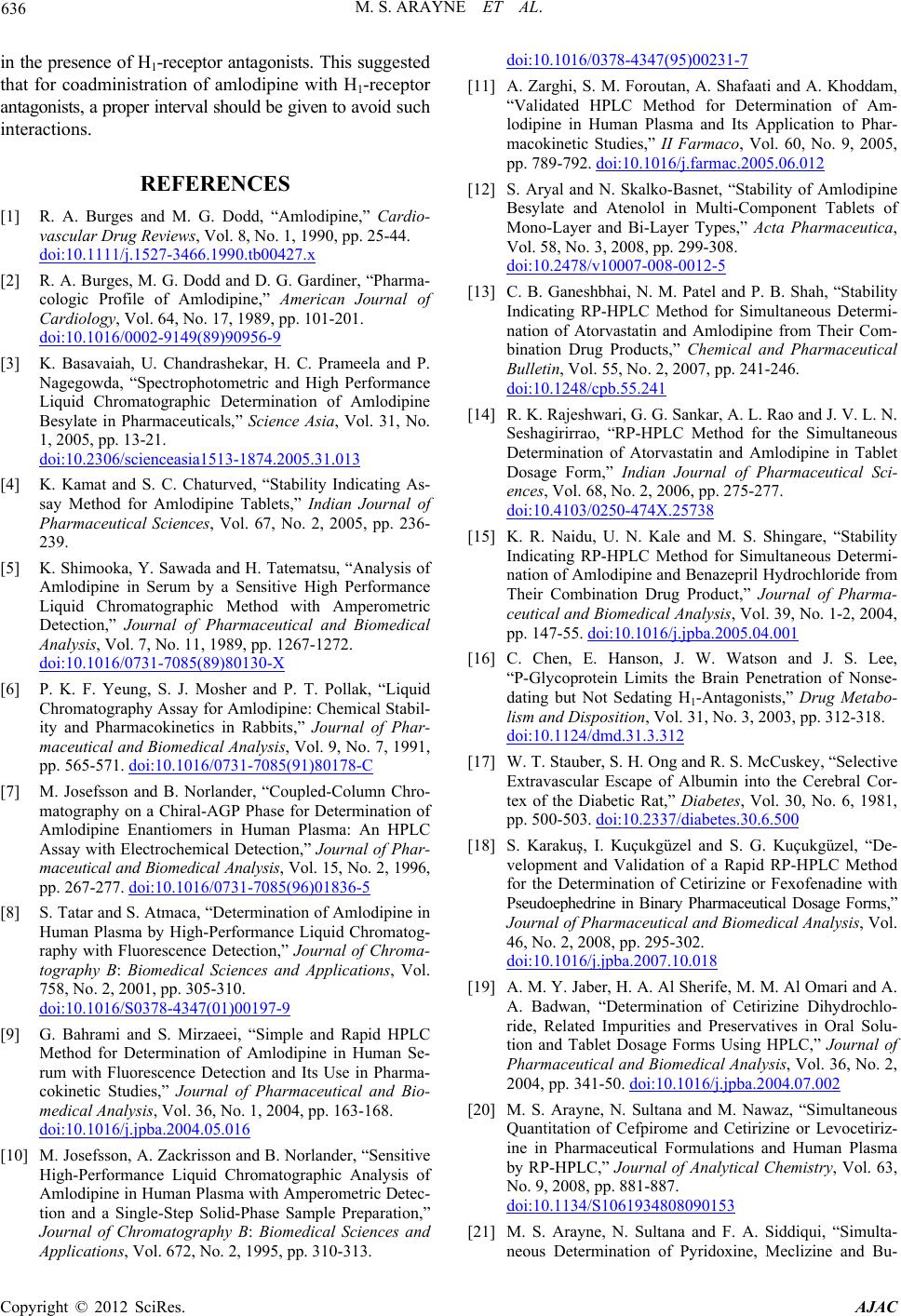
M. S. ARAYNE ET AL.
636
in the presence of H1-receptor antagonists. This suggested
that for coadministration of amlodipine with H1-receptor
antagonists, a proper interval should be given to avoid such
interactions.
REFERENCES
[1] R. A. Burges and M. G. Dodd, “Amlodipine,” Cardio-
vascular Drug Reviews, Vol. 8, No. 1, 1990, pp. 25-44.
doi:10.1111/j.1527-3466.1990.tb00427.x
[2] R. A. Burges, M. G. Dodd and D. G. Gardiner, “Pharma-
cologic Profile of Amlodipine,” American Journal of
Cardiology, Vol. 64, No. 17, 1989, pp. 101-201.
doi:10.1016/0002-9149(89)90956-9
[3] K. Basavaiah, U. Chandrashekar, H. C. Prameela and P.
Nagegowda, “Spectrophotometric and High Performance
Liquid Chromatographic Determination of Amlodipine
Besylate in Pharmaceuticals,” Science Asia, Vol. 31, No.
1, 2005, pp. 13-21.
doi:10.2306/scienceasia1513-1874.2005.31.013
[4] K. Kamat and S. C. Chaturved, “Stability Indicating As-
say Method for Amlodipine Tablets,” Indian Journal of
Pharmaceutical Sciences, Vol. 67, No. 2, 2005, pp. 236-
239.
[5] K. Shimooka, Y. Sawada and H. Tatematsu, “Analysis of
Amlodipine in Serum by a Sensitive High Performance
Liquid Chromatographic Method with Amperometric
Detection,” Journal of Pharmaceutical and Biomedical
Analysis, Vol. 7, No. 11, 1989, pp. 1267-1272.
doi:10.1016/0731-7085(89)80130-X
[6] P. K. F. Yeung, S. J. Mosher and P. T. Pollak, “Liquid
Chromatography Assay for Amlodipine: Chemical Stabil-
ity and Pharmacokinetics in Rabbits,” Journal of Phar-
maceutical and Biomedical Analysis, Vol. 9, No. 7, 1991,
pp. 565-571. doi:10.1016/0731-7085(91)80178-C
[7] M. Josefsson and B. Norlander, “Coupled-Column Chro-
matography on a Chiral-AGP Phase for Determination of
Amlodipine Enantiomers in Human Plasma: An HPLC
Assay with Electrochemical Detection,” Journal of Phar-
maceutical and Biomedical Analysis, Vol. 15, No. 2, 1996,
pp. 267-277. doi:10.1016/0731-7085(96)01836-5
[8] S. Tatar and S. Atmaca, “Determination of Amlodipine in
Human Plasma by High-Performance Liquid Chromatog-
raphy with Fluorescence Detection,” Journal of Chroma-
tography B: Biomedical Sciences and Applications, Vol.
758, No. 2, 2001, pp. 305-310.
doi:10.1016/S0378-4347(01)00197-9
[9] G. Bahrami and S. Mirzaeei, “Simple and Rapid HPLC
Method for Determination of Amlodipine in Human Se-
rum with Fluorescence Detection and Its Use in Pharma-
cokinetic Studies,” Journal of Pharmaceutical and Bio-
medical Analysis, Vol. 36, No. 1, 2004, pp. 163-168.
doi:10.1016/j.jpba.2004.05.016
[10] M. Josefsson, A. Zackrisson and B. Norlander, “Sensitive
High-Performance Liquid Chromatographic Analysis of
Amlodipine in Human Plasma with Amperometric Detec-
tion and a Single-Step Solid-Phase Sample Preparation,”
Journal of Chromatography B: Biomedical Sciences and
Applications, Vol. 672, No. 2, 1995, pp. 310-313.
doi:10.1016/0378-4347(95)00231-7
[11] A. Zarghi, S. M. Foroutan, A. Shafaati and A. Khoddam,
“Validated HPLC Method for Determination of Am-
lodipine in Human Plasma and Its Application to Phar-
macokinetic Studies,” II Farmaco, Vol. 60, No. 9, 2005,
pp. 789-792. doi:10.1016/j.farmac.2005.06.012
[12] S. Aryal and N. Skalko-Basnet, “Stability of Amlodipine
Besylate and Atenolol in Multi-Component Tablets of
Mono-Layer and Bi-Layer Types,” Acta Pharmaceutica,
Vol. 58, No. 3, 2008, pp. 299-308.
doi:10.2478/v10007-008-0012-5
[13] C. B. Ganeshbhai, N. M. Patel and P. B. Shah, “Stability
Indicating RP-HPLC Method for Simultaneous Determi-
nation of Atorvastatin and Amlodipine from Their Com-
bination Drug Products,” Chemical and Pharmaceutical
Bulletin, Vol. 55, No. 2, 2007, pp. 241-246.
doi:10.1248/cpb.55.241
[14] R. K. Rajeshwari, G. G. Sankar, A. L. Rao and J. V. L. N.
Seshagirirrao, “RP-HPLC Method for the Simultaneous
Determination of Atorvastatin and Amlodipine in Tablet
Dosage Form,” Indian Journal of Pharmaceutical Sci-
ences, Vol. 68, No. 2, 2006, pp. 275-277.
doi:10.4103/0250-474X.25738
[15] K. R. Naidu, U. N. Kale and M. S. Shingare, “Stability
Indicating RP-HPLC Method for Simultaneous Determi-
nation of Amlodipine and Benazepril Hydrochloride from
Their Combination Drug Product,” Journal of Pharma-
ceutical and Biomedical Analysis, Vol. 39, No. 1-2, 2004,
pp. 147-55. doi:10.1016/j.jpba.2005.04.001
[16] C. Chen, E. Hanson, J. W. Watson and J. S. Lee,
“P-Glycoprotein Limits the Brain Penetration of Nonse-
dating but Not Sedating H1-Antagonists,” Drug Metabo-
lism and Disposition, Vol. 31, No. 3, 2003, pp. 312-318.
doi:10.1124/dmd.31.3.312
[17] W. T. Stauber, S. H. Ong and R. S. McCuskey, “Selective
Extravascular Escape of Albumin into the Cerebral Cor-
tex of the Diabetic Rat,” Diabetes, Vol. 30, No. 6, 1981,
pp. 500-503. doi:10.2337/diabetes.30.6.500
[18] S. Karakuş, I. Kuçukgüzel and S. G. Kuçukgüzel, “De-
velopment and Validation of a Rapid RP-HPLC Method
for the Determination of Cetirizine or Fexofenadine with
Pseudoephedrine in Binary Pharmaceutical Dosage Forms,”
Journal of Pharmaceutical and Biomedical Analysis, Vol.
46, No. 2, 2008, pp. 295-302.
doi:10.1016/j.jpba.2007.10.018
[19] A. M. Y. Jaber, H. A. Al Sherife, M. M. Al Omari and A.
A. Badwan, “Determination of Cetirizine Dihydrochlo-
ride, Related Impurities and Preservatives in Oral Solu-
tion and Tablet Dosage Forms Using HPLC,” Journal of
Pharmaceutical and Biomedical Analysis, Vol. 36, No. 2,
2004, pp. 341-50. doi:10.1016/j.jpba.2004.07.002
[20] M. S. Arayne, N. Sultana and M. Nawaz, “Simultaneous
Quantitation of Cefpirome and Cetirizine or Levocetiriz-
ine in Pharmaceutical Formulations and Human Plasma
by RP-HPLC,” Journal of Analytical Chemistry, Vol. 63,
No. 9, 2008, pp. 881-887.
doi:10.1134/S1061934808090153
[21] M. S. Arayne, N. Sultana and F. A. Siddiqui, “Simulta-
neous Determination of Pyridoxine, Meclizine and Bu-
Copyright © 2012 SciRes. AJAC